When you buy through our links, we may earn an affiliate commission.
It doesn't matter what craft you're learning, we recommend that you train like Michael Jordan if you want to be good. That means, taking lessons even once you've advanced past the beginner and early intermediate stages of learning your instrument. Playing an instrument is like training a muscle, and the more you work at it the easier it becomes to play relaxed. When you're relaxed, that's when you're at your best.
For drummers looking to advance their skills past the intermediate level, we recommend taking advanced classes. These advanced classes are great for people of all ages and are designed to strengthen skills you already have, along with teaching you new ones.
Whether you're looking to become a touring musician or session musician, these online lessons for advanced players will train you to be ready for when the day comes. We recommend taking the challenge.
Based on experience, we gathered these courses that we would personally take as a way to advance our drum skills. Here are 5 of the best drum lessons for advanced players.
1. How To Play “Invincible” by Tool
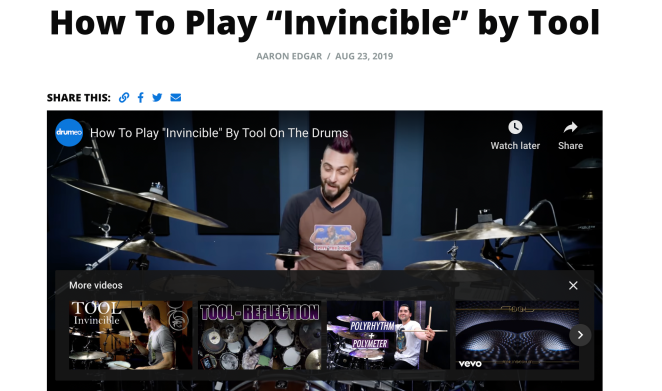
The Scoop:
Learn the drums faster with step-by-step lessons, thousands of songs, and unlimited personal support. Fear Innoculum, the long-awaited 5th album by Tool gave us "Invincible." Like most Tool songs, this song isn't easy to play. Danny Carey is one of the best, and you'll learn exactly why. It's definitely a song we recommend for advanced players to give a try.
Key Features:
Aaron Edgar will get you through the 7 over 3 polyrhythms. (Drumeo has a course dedicated to Tool's polyrhythms. Awesome, right?) If you didn't cover polyrhythms in beginner or intermediate, we recommend taking a course, however, you can go as slow as you need. We also recommend practicing on just the hi-hat if you're having trouble bringing a beat together. Once it's time to play it on the drum set full-out, it'll make more sense.
2. Advanced Sextuplet Chops - Gospel Chops Drumming Masterclass
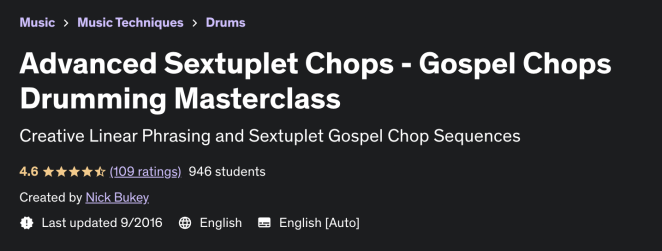
The Scoop:
This course consists of 20 lessons explicitly teaching advanced linear sextuplet phrasing. You will learn to play a variety of innovative, challenging, and inspiring gospel chop sequences.
We're big fans of drummers of all styles at American Songwriter, including gospel. One of our writer's first drum lessons as a kid was actually from a gospel drummer. Why is that? Those drums are pretty loud and definitely encourage you to hit hard. If you're a rock drummer and have an interest in gospel chops, this course is for you as well.
Key Features:
This course gives you a new tool kit for linear sextuplet phrasing. You'll create your own licks, fills, patterns, and songs after taking this course. Also, if you hate online drum lessons with lots of talking, you'll like this course. Nick Bukey likes to get straight to the point and show you demonstrations and sheet music.
We highly encourage you to have a basic understanding of drum notation for this course or at least be eager to sharpen your notation skills. Lots of great drummers can't read music (surprise), but this course will help you out. You'll be improvising with strong gospel chops in no time.
Want to Read More About Drums? See the Best Drumheads for Rock Here
3. Take your double bass drum technique to the next level
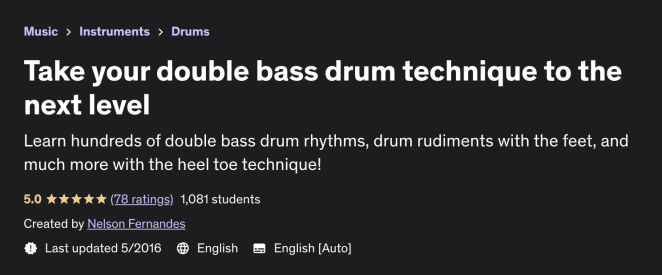
The Scoop:
Learn hundreds of double bass drum rhythms, drum rudiments with the feet, and much more with the heel-toe technique.
So, you've mastered limb independence. Or at least you feel like you have for the most part. But you might feel like your bass needs some technique. Our drummers at American Songwriter recommend this course for rock-style drummers.
Key Features:
Nelson Fernandes, the instructor, definitely recommends this course for metal and session drummers. You'll learn the heel-toe technique with both feet for a smooth sound. Trust us, you can mess up a crash and most non-drummers won't notice, but a bass that sounds off is super noticeable. With this technique, your bass will sound polished and loud.
You'll become a pro on how to do a double-stroke roll and more. You'll be equipped with double pedal exercises that will make drum solos sound 100 times better. Plus, there are hundreds of guitar riffs included so you can play along with them. No need to hunt down an app or buddy to play music. You can practice this course completely solo.
4. Drumming Into Jazz - Prepare for Jazz Band Audition
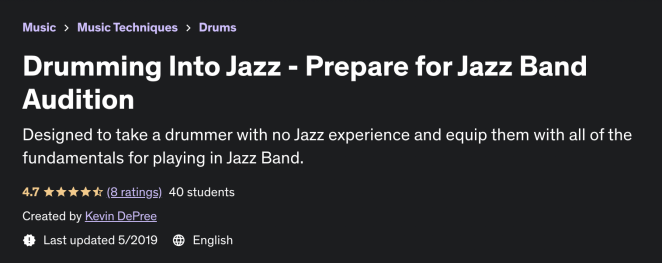
The Scoop:
Designed to take a drummer with no Jazz experience and equip them with all of the fundamentals for playing in Jazz Band.
Drum auditions can be tough. Whether it's a band or producer at your auditions, everyone needs to know if you're going to fold under pressure.
Key Features:
With this course, you'll approach band auditions with a new technique, more specifically jazz band auditions. So, whether it's a cover band or you're looking to be a session drummer, this course has you covered. You'll learn audition preparation, and coordination warm-ups for swing, bossa nova, waltz, and funk styles. These advanced jazz comping patterns will definitely prepare you for what's to come as a jazz band drummer. You can also expect chart reading, solo exercises, push beats, triplet stickings and accent patterns, and a whole lot more.
5. Drum Recording Techniques
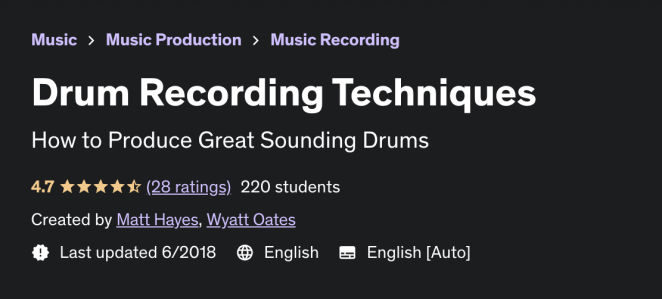
The Scoop:
This course aims to simplify the process by breaking down all of the variables that go into recording a drum kit: from working with your drummer to choosing how many microphones to use, which microphones to choose, where to place them, and how to use effects when recording.
Recording drums is a skill every drummer needs if they want to be a professional musician. Luckily for you, you might already have a little bit of knowledge in this subject if you've already been in a studio or performed live gigs.
Key Features:
Part of this course is learning about drum mic kits. (We have a selection of our favorite kits in case you're looking for one). You'll learn how to set up a studio and also learn how to use effects and how to mix. The recording session will be fun to watch. Be ready to take some notes. If you have Pro Tools, you're already on the right track. Your band will thank you for taking this course, and you'll one day thank yourself for taking it if you plan on releasing your own music one day.
What is "Advanced" Drumming
When you begin to feel "bored" with your drumming, this may be a sign you're ready to move on to more advanced playing. Some examples of advanced drumming are: learning tricky 16th note grooves, writing drum fills, and increasing the difficulty of song covers with lots of limb independence. (Get ready for some polyrhythms.)
Note: Finding difficult songs to cover is quite simple. Ask your drum teacher for recommendations or listen to music. Listen to the greats! Dive into the history of drumming. Begin to develop a strong ear for quality, drum writing. Some other examples of advanced drumming can be producing and editing your own music with effects. It's a large pool, so narrow down exactly what you want to advance in. Another example is bass pedal technique (great if you've just upgraded to a double bass pedal).
In-Person vs. Online Lessons for Every Drummer
In-person classes are great. We recommend in-person classes for everyone, especially if you need the discipline to get started. However, we know in-person classes are generally much more expensive than online lessons.
You can find online courses anywhere between $25-$200. Some will get you access to one topic for around $30 or so, and some will cover several beginner, intermediate, or advanced lessons for $150-$200.
Besides pricing, we also enjoy the flexibility of online courses. Life happens. You can't always stick to 1 or 2 days out of the week to learn. Plus, online classes typically give you lifetime access to videos, so you can always go back and watch them.
Tips for Staying Committed to Lessons
Practice. Practice. Practice. Even if you don't get on the kit, have your drum pad nearby. Also, schedule practices in a planner or in your drum journal and write down your pain points and exactly what you're working on. This will prevent you from mindlessly scrolling through lessons or staring at sheet music. And if you're staring at sheet music... that could be a sign that it's time to sharpen your notation skills. Another great tip for staying on track is having a well-written lesson plan. You can find some for free online or you can find an online instructor that offers plans from beginner to advanced.
Also, it's easier (and more fun) to stay committed to drumming when you're actually improving. Again, practice, practice, practice. Even if this means watching TV while practicing on the drum pad. Every minute counts, so start planning your practice schedule.
What You Need for Online Drum Lessons
We recommend having access to a kit. You can likely find drum studios near you to rent by the hour if you don't have an acoustic or electronic kit. Depending on the area, prices can range from $8-$16 an hour.
Bring a tablet, laptop, or printed sheet music to study. You'll want an internet connection to watch your videos and another screen (or printed music) to follow along. And of course, ear protection. We typically aren't always wearing ear protection for hitting super lightly in beginner lessons, but as you get comfortable and begin hitting harder, you'll want to wear ear protection to prevent long-term hearing damage.
Online Drum Lesson Price Ranges
Drum lessons can range from person to person. Typically, you'll pay about $30-$45 for a 30-minute lesson and $50-$75 for an in-person lesson. We recommend getting the best bang for the buck. If you can find a reputable drum teacher that charges no more than $60 an hour, that's great. However, we do think that 30-minute lessons fly by, so consider 1-hour lessons after getting some of the basics down.
Photo by Gettyimages.com
